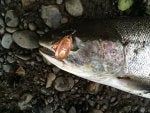A few people have pinged me lately asking for tips for fishing casting spinners. I'm no pro, but I catch a few and use casting spinners pretty much exclusively for salmon & steelhead year round. Here are a few tips that work for me. I'm hoping you other gear chuckers will add a few thoughts of your own.
![Image]()
- Read the bible (Spinner fishing for steelhead, salmon & trout by Jed Davis).
- Preferred rod for me is an 8-6 baitcaster and 8-17lb. Easier to control casts and stick slack line bites. Some guys even go 10-20lb but personally I think the 8-17lb is a happy medium that telegraphs blade thump better.
- For summer steelhead I go 12lb ultragreen-->swivel-->fluoro leader-->lure. For everything else I go 30# braid-->swivel-->fluoro leader-->lure.
- Fish near the bottom. Fish generally hang out near the bottom...your spinner should be there as much as possible. A weighted spinner like the ones we sell do a very good job of getting and staying in the zone.
- Slow as possible retrieve. Can't stress this enough.
- If you read Jed's book (mentioned above) you'll find that he has specific spinner colors and finishes mapped out for just about every conceivable weather condition, water clarity, temperature range and every other variable possible. For beginners I suggest starting simple. Contrast is good. A blade with some flash and a darker-colored body is a good bet. My favorite, by far, is our genuine white silver blade & black body (pictured below). Believe it or not...it is the only spinner I carry and have lost count of how many days we've caught steelhead, chinook and coho all on the same day, all on the same spinner. Once you start catching fish and gaining confidence you can branch out into other combos.
- Move. Hit a spot, cover it well and if you haven't had any action move up or downstream. Keep moving (if possible) and cover a lot of water. If you favor certain spots you can always come back and hit those spots again multiple times just don't camp out unless your continuously catching fish there.
- Let the current do the work. Cast upstream, let lure sink, mend or let out line and allow current to work the lure. Often it's the bend in your line that will be what's working the lure. As my friend Mr Fast says "the bend is your friend." Watch tip of rod...if it's slowly bouncing up and down you know your spinner is working properly.








